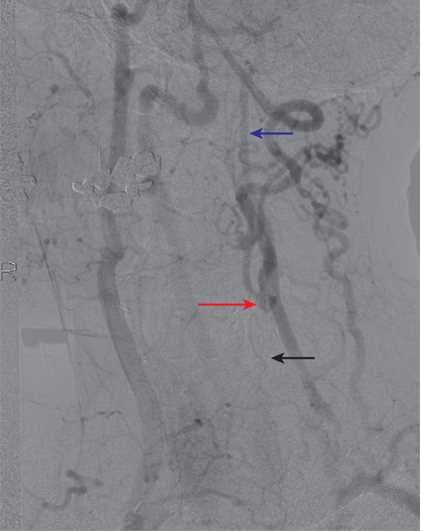[1]
Doonan RJ, Abdullah A, Steinmetz-Wood S, Mekhaiel S, Steinmetz OK, Obrand DI, Corriveau MM, Mackenzie KS, Gill HL. Carotid Endarterectomy Outcomes in the Elderly: A Canadian Institutional Experience. Annals of vascular surgery. 2019 Aug:59():16-20. doi: 10.1016/j.avsg.2018.12.084. Epub 2019 Feb 22
[PubMed PMID: 30802579]
[2]
Morales MM, Anacleto A, Filho CM, Ledesma S, Aldrovani M, Wolosker N. Peak Systolic Velocity for Calcified Plaques Fails to Estimate Carotid Stenosis Degree. Annals of vascular surgery. 2019 Aug:59():1-4. doi: 10.1016/j.avsg.2018.12.086. Epub 2019 Feb 22
[PubMed PMID: 30802575]
[3]
Savardekar AR, Narayan V, Patra DP, Spetzler RF, Sun H. Timing of Carotid Endarterectomy for Symptomatic Carotid Stenosis: A Snapshot of Current Trends and Systematic Review of Literature on Changing Paradigm towards Early Surgery. Neurosurgery. 2019 Aug 1:85(2):E214-E225. doi: 10.1093/neuros/nyy557. Epub
[PubMed PMID: 30799491]
Level 1 (high-level) evidence
[4]
Coelho AP, Lobo M, Nogueira C, Gouveia R, Campos J, Augusto R, Coelho N, Semião AC, Canedo A. Overview of evidence on risk factors and early management of acute carotid stent thrombosis during the last two decades. Journal of vascular surgery. 2019 Mar:69(3):952-964. doi: 10.1016/j.jvs.2018.09.053. Epub
[PubMed PMID: 30798846]
Level 3 (low-level) evidence
[5]
Texakalidis P, Chaitidis N, Giannopoulos S, Giannopoulos S, Machinis T, Jabbour P, Rivet D, Reavey-Cantwell J, Rangel-Castilla L. Carotid Revascularization in Older Adults: A Systematic Review and Meta-Analysis. World neurosurgery. 2019 Jun:126():656-663.e1. doi: 10.1016/j.wneu.2019.02.030. Epub 2019 Feb 22
[PubMed PMID: 30797928]
Level 1 (high-level) evidence
[6]
Tokugawa J, Kudo K, Mitsuhashi T, Yanagisawa N, Nojiri S, Hishii M. Surgical Results of Carotid Endarterectomy for Twisted Carotid Bifurcation. World neurosurgery. 2019 Jun:126():e153-e156. doi: 10.1016/j.wneu.2019.01.282. Epub 2019 Feb 19
[PubMed PMID: 30794973]
[7]
Wangqin R, Krafft PR, Piper K, Kumar J, Xu K, Mokin M, Ren Z. Management of De Novo Carotid Stenosis and Postintervention Restenosis-Carotid Endarterectomy Versus Carotid Artery Stenting-a Review of Literature. Translational stroke research. 2019 Oct:10(5):460-474. doi: 10.1007/s12975-019-00693-z. Epub 2019 Feb 22
[PubMed PMID: 30793257]
Level 2 (mid-level) evidence
[8]
Gaba K, Bulbulia R. Identifying asymptomatic patients at high-risk for stroke. The Journal of cardiovascular surgery. 2019 Jun:60(3):332-344. doi: 10.23736/S0021-9509.19.10912-3. Epub 2019 Feb 20
[PubMed PMID: 30785251]
[9]
Lamanna A, Maingard J, Barras CD, Kok HK, Handelman G, Chandra RV, Thijs V, Brooks DM, Asadi H. Carotid artery stenting: Current state of evidence and future directions. Acta neurologica Scandinavica. 2019 Apr:139(4):318-333. doi: 10.1111/ane.13062. Epub 2019 Feb 6
[PubMed PMID: 30613950]
Level 3 (low-level) evidence
[10]
Ong CT, Wong YS, Sung SF, Wu CS, Hsu YC, Su YH, Hung LC. Progression of Mild to Moderate Stenosis in the Internal Carotid Arteries of Patients With Ischemic Stroke. Frontiers in neurology. 2018:9():1043. doi: 10.3389/fneur.2018.01043. Epub 2018 Dec 3
[PubMed PMID: 30559712]
[11]
Li Y, Zhu G, Ding V, Huang Y, Jiang B, Ball RL, Rodriguez F, Fleischmann D, Desai M, Saloner D, Saba L, Hom J, Wintermark M. Assessing the Relationship between Atherosclerotic Cardiovascular Disease Risk Score and Carotid Artery Imaging Findings. Journal of neuroimaging : official journal of the American Society of Neuroimaging. 2019 Jan:29(1):119-125. doi: 10.1111/jon.12573. Epub 2018 Oct 25
[PubMed PMID: 30357980]
[12]
Müller MD, Lyrer P, Brown MM, Bonati LH. Carotid artery stenting versus endarterectomy for treatment of carotid artery stenosis. The Cochrane database of systematic reviews. 2020 Feb 25:2(2):CD000515. doi: 10.1002/14651858.CD000515.pub5. Epub 2020 Feb 25
[PubMed PMID: 32096559]
Level 1 (high-level) evidence
[13]
Mac Grory B, Flood SP, Apostolidou E, Yaghi S. Cryptogenic Stroke: Diagnostic Workup and Management. Current treatment options in cardiovascular medicine. 2019 Dec 3:21(11):77. doi: 10.1007/s11936-019-0786-4. Epub 2019 Dec 3
[PubMed PMID: 31792625]
[14]
Tancin Lambert A, Kong XY, Ratajczak-Tretel B, Atar D, Russell D, Skjelland M, Bjerkeli V, Skagen K, Coq M, Schordan E, Firat H, Halvorsen B, Aamodt AH. Biomarkers Associated with Atrial Fibrillation in Patients with Ischemic Stroke: A Pilot Study from the NOR-FIB Study. Cerebrovascular diseases extra. 2020:10(1):11-20. doi: 10.1159/000504529. Epub 2020 Feb 6
[PubMed PMID: 32028277]
Level 3 (low-level) evidence
[15]
Michailidou D, Rosenblum JS, Rimland CA, Marko J, Ahlman MA, Grayson PC. Clinical symptoms and associated vascular imaging findings in Takayasu's arteritis compared to giant cell arteritis. Annals of the rheumatic diseases. 2020 Feb:79(2):262-267. doi: 10.1136/annrheumdis-2019-216145. Epub 2019 Oct 24
[PubMed PMID: 31649025]
[16]
Scoutt LM, Gunabushanam G. Carotid Ultrasound. Radiologic clinics of North America. 2019 May:57(3):501-518. doi: 10.1016/j.rcl.2019.01.008. Epub 2019 Feb 22
[PubMed PMID: 30928074]
[17]
Brott TG, Calvet D, Howard G, Gregson J, Algra A, Becquemin JP, de Borst GJ, Bulbulia R, Eckstein HH, Fraedrich G, Greving JP, Halliday A, Hendrikse J, Jansen O, Voeks JH, Ringleb PA, Mas JL, Brown MM, Bonati LH, Carotid Stenosis Trialists' Collaboration. Long-term outcomes of stenting and endarterectomy for symptomatic carotid stenosis: a preplanned pooled analysis of individual patient data. The Lancet. Neurology. 2019 Apr:18(4):348-356. doi: 10.1016/S1474-4422(19)30028-6. Epub 2019 Feb 6
[PubMed PMID: 30738706]

